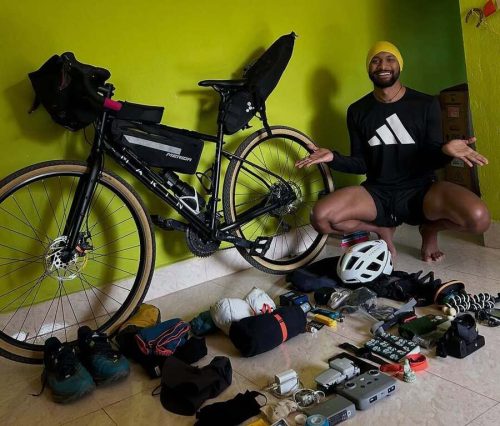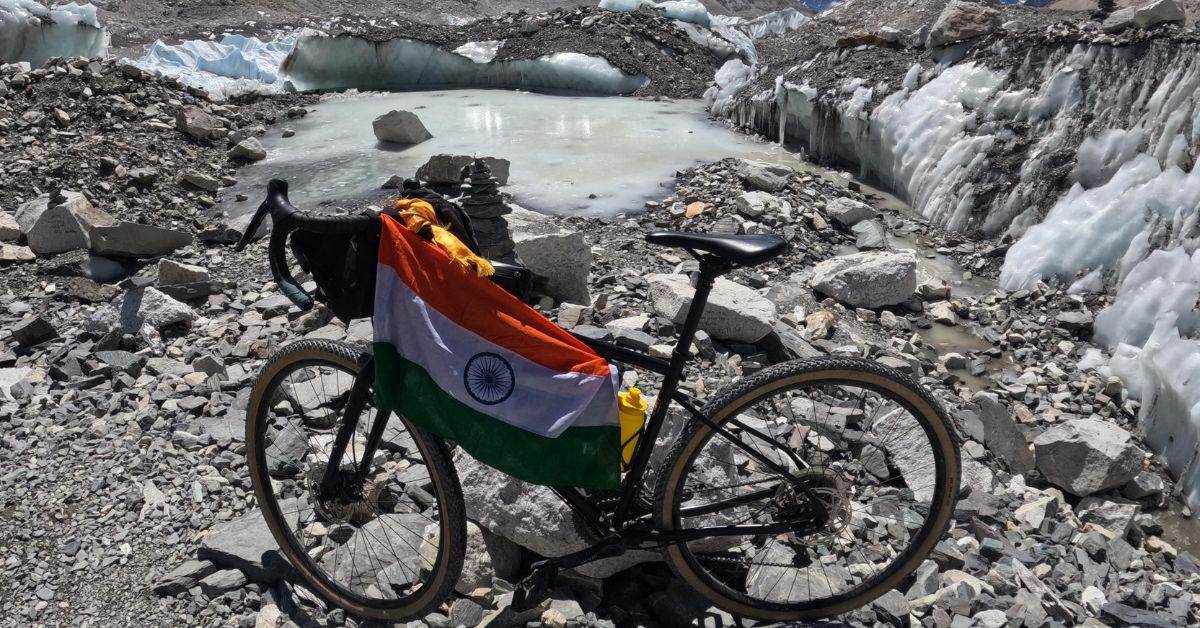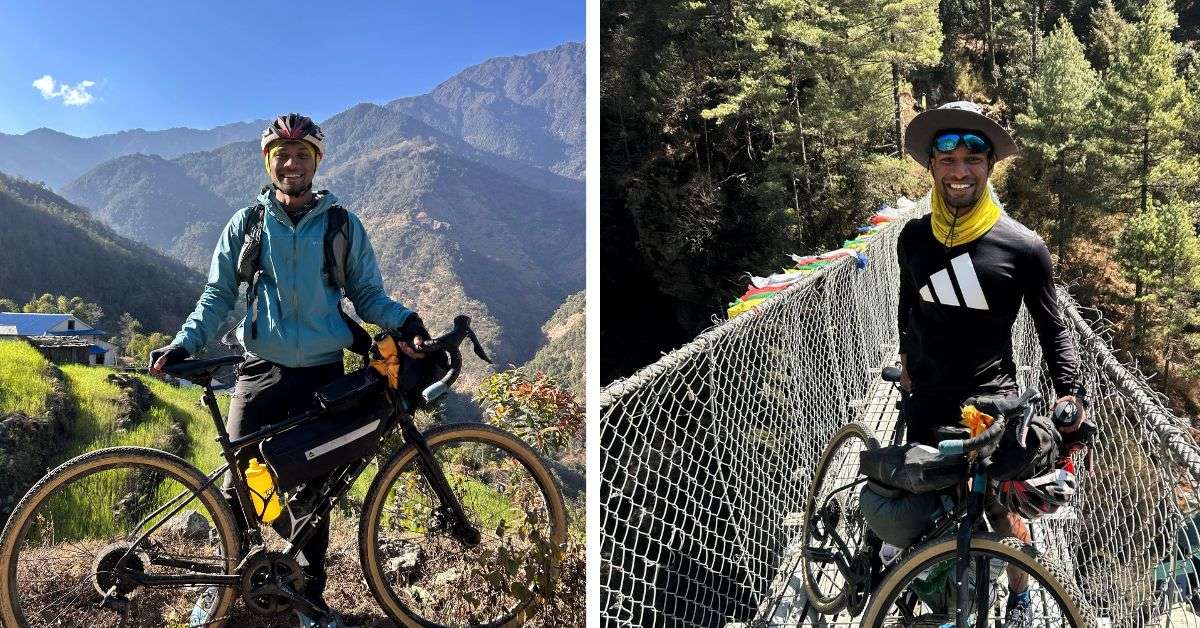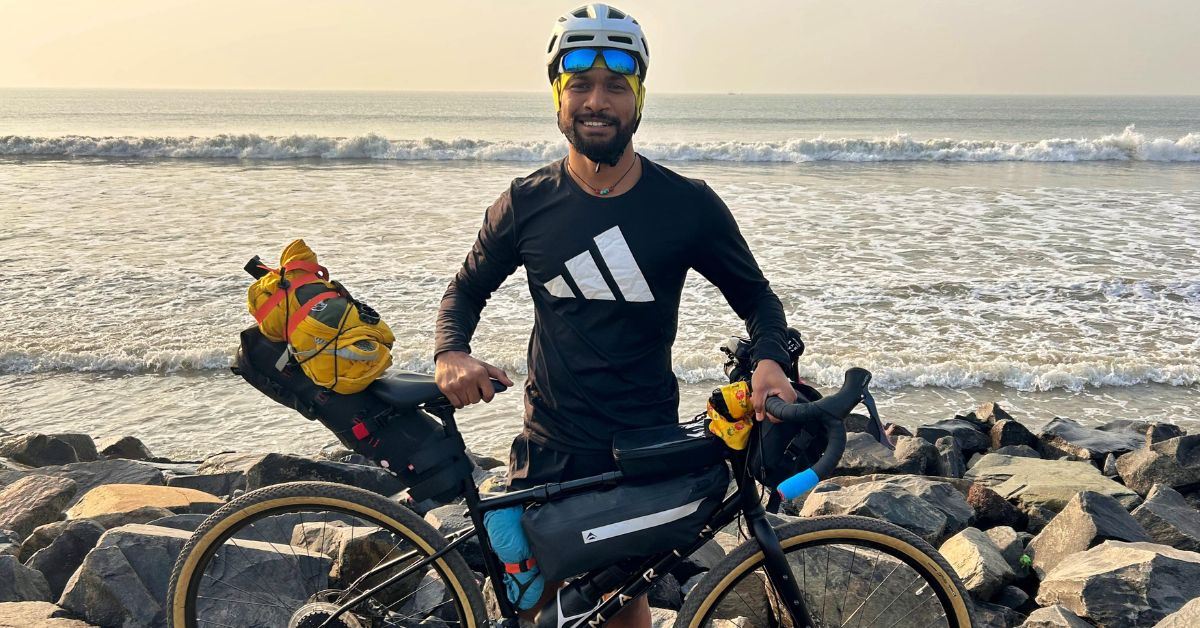Some journeys don’t begin with big announcements or detailed plans. They start with a simple quiet idea; one that grows slowly, takes shape over time, and then refuses to let go.
A classic example of the same is the story of 29-year-old Jyotishko Biswas, a mountaineering instructor from West Bengal. He wasn’t chasing a record or prize. This journey, as he puts it, was “a test of mental and physical limits.”
It was also a message — about discipline, about possibilities, and about the importance of challenging oneself in a world that often encourages comfort.

‘There is more to life than just scrolling through smartphones’
Jyotishko has been mountaineering and cycling for over six years. “I work as an instructor at the Himalayan Mountaineering Institute in Darjeeling,” he shares. “I also run a trekking community and often take people to the mountains.”
The idea of cycling from sea level to the base of the world’s tallest mountain was born out of this background in outdoor endurance, but it was more than just a personal challenge.
“I wanted to do something that no Indian had done before, something difficult, something that would push the boundaries of my mental state. And more than anything, I wanted to show the younger generation that there’s more to life than scrolling through phones all day,” he says.

Jyotishko speaks passionately about how physical and mental health are connected. Long-distance cycling demands intense physical strength, yes, but it also requires mental clarity, patience, and resilience. The rhythm of pedalling for hours on end, often through silence or solitude, offers a kind of moving meditation. “When your body is in motion, your thoughts slow down,” he often says.
The challenges of the road — steep climbs, unpredictable weather, or the sheer monotony of empty stretches — mirror the mental hurdles one faces in everyday life.
His mission was not only to reach Everest Base Camp on a cycle but to start conversations about mental resilience, outdoor fitness, and personal growth through discomfort. “I wanted to set an example, not as someone special, but as someone ordinary doing something unusual.”
Cycling also unlocks a rare sense of freedom. With every push of the pedal, the mind begins to untangle itself from clutter, anxiety, or fear. The fresh air, the changing landscapes, the awareness of your breath and heartbeat — all of it grounds you in the present. For someone like Jyotishko, whose journeys often stretch over days and cross borders, the cycle becomes more than a machine — it’s a bridge between physical wellbeing and emotional strength.
The community that followed
Though the ride was mostly solo, Jyotishko wasn’t alone in spirit. Over the years, he’s built strong connections in trekking and cycling communities across India and Nepal. While they didn’t fund his journey, many cheered him on and helped with logistics and morale.
Originally from Arunachal Pradesh, Jyotishko has been living in West Bengal for work. “I have always stayed in touch with Sherpa friends in Nepal, local guides, and even helped a school in Monjo by sending some supplies from Kathmandu before beginning the final trek,” he recalls. “So, in a way, this wasn’t just my journey. It was about the people and the communities that make up the Himalayan belt,” he adds.
“For most people, just reaching Mount Everest Base Camp is a once-in-a-lifetime achievement. Jyotishko didn’t just get there — he cycled from West Bengal,” says Malay Mukherjee, a veteran adventurer, cyclist, and Everest climber. Having mentored and witnessed many mountaineers over his 26-year career, Malay doesn’t hold back his admiration.
Pedals, patience, and preparation
Jyotishko started his journey on 9 February 2024 from Digha. The route spanned around 1,346 kilometres, cutting through West Bengal, into Nepal through Kakarbhitta, and finally to Everest Base Camp via Itahari, Okhaldhunga, Salleri, Namche Bazaar, and Gorakshep.

Poulami, a homegrown brand owner and fitness enthusiast from Kolkata, remembers the exact moment she crossed paths with Jyotishko — during his cycling journey from Digha, right before he reached Ranaghat. “I met him at a café in Kolkata and was immediately struck by his energy — the aura around his cycle, his kit, the way he carried the entire expedition. It was unlike anything I’d seen,” she recalls. “Someone from a small village in Bengal, doing something so big, so fearlessly — that deeply inspired me. His journey felt personal. It wasn’t just about Everest, it was about daring to dream limitlessly.”
The early stretch through West Bengal came with its hurdles. “The heatwave was brutal,” he recalls. “It was humid, the highways were tough, and the sun showed no mercy.” Yet, this wasn’t unexpected.
Jyotishko had spent nearly two years preparing — mentally, physically, and financially — for this solo expedition. “It was self-funded. I reached out to communities and organisations for help, but nothing worked out. So I worked and saved for years. It was just me and my father managing everything.”
“You could call him my student, my colleague, or my younger brother. He’s truly a remarkable young man. What he’s done isn’t just bold — it demands grit, discipline, and relentless hard work. When I was 21, I walked 2,500 kilometres from Gangasagar to Gomukh, so I know what it takes. Jyotishko has everything — passion, planning, and purpose. That’s what makes him exceptional,” Malay adds.
As the terrain shifted, so did the challenges. Flat roads gave way to steep gradients, rocky trails, and muddy, landslide-prone paths. “After the India-Nepal border, things got harder. Nepal’s roads can be rough in places, and there were sections where I had to carry the cycle on my back. Especially near the higher altitudes, where the oxygen levels drop, it becomes more of a battle against your own body.”
A climb beyond comfort
Beyond Salleri, the real climb began. Each day meant pushing the body a little further past what seemed possible. “It was no longer about riding. The roads were too bad or nonexistent in places. I had to walk with my cycle, carry it over boulders and narrow tracks,” he explains. “There were stretches where I couldn’t ride at all.”

The isolation hit hard too. “There’s no backup vehicle, no one to fix your gear, no quick access to medical help. You have to ration your food, fix your cycle, and keep going. That kind of self-reliance teaches you things you don’t learn in books.”
Despite all this, Jyotishko remained focused. “This journey wasn’t just about me,” he says. “I wanted to talk about climate, about schools in the mountains, about people who live in these regions, and how we ignore their struggles.” Through his ride, Jyotishko hoped to spotlight how climate change is already altering fragile Himalayan ecosystems — glaciers are receding, weather patterns are shifting, and traditional ways of life are being disrupted. “These regions contribute the least to global emissions, yet face the harshest consequences,” he adds.
During a stop at a small school in Surke, near Monjo, Jyotishko spent time with students and tried to support them in whatever little way he could — whether through supplies, conversations, or simply showing up. He donated stationery, books, and some thermal wear he had carried with him, knowing how biting the mountain cold can be. But it was the conversations that stayed with him. “One boy told me his favourite subject was science, but their textbooks were outdated and their lab had nothing but a single broken microscope. It struck me — we speak of development, but forget those who are left out of the story.”
For Jyotishko, this interaction was a quiet reminder that adventure should not exist in a vacuum. “It’s not just about personal milestones,” he says. “If we’re passing through these places, we carry a responsibility — to listen, to learn, and to give back, even in the smallest of ways.”
The final ascent
After 29 days on the road, Jyotishko reached Everest Base Camp on 10 March 2024. “The last few kilometres were the hardest,” he recalls.
“The terrain near Gorakshep is pure rock and ice. The wind is strong. Temperatures drop fast. At that altitude, everything becomes slow and painful. But giving up wasn’t an option.”Looking back, he says, “It was never about comfort. It was about resilience. Pushing through pain, doubt, and fear. That’s what this journey meant.”
Lessons from the road
When asked about the biggest challenges, Jyotishko mentions more than just terrain. “The real challenge is your mind,” he says. “Everything — heat, cold, fatigue — can be managed. But when your mind gives up, your body follows. I had to constantly remind myself why I started.”

But what keeps him going? “Support from my father,” he says without hesitation. “He’s my biggest strength. Many people don’t get that kind of backing, especially in Indian families where such pursuits are often dismissed. I want more families to be like that—open, encouraging, and ready to let young people chase difficult dreams.”
The road ahead
For someone who’s just completed a sea-to-summit journey, Jyotishko isn’t resting on his achievements. “This is just the beginning,” he smiles. “I want to go to schools, share my experiences, talk about climate, and show what it means to step out of your comfort zone. I believe we need more conversations about these things—about discipline, about the outdoors, and mental strength.”
He also dreams of growing the initiative into something larger. “I want to motivate more people. Maybe conduct cycling and trekking camps for school kids, talk about climate change, and connect with more communities. But I’ll need help for that — whether it’s organisations, policymakers, or individuals who want to contribute.”
When asked how people can support his journey, he says, “Even listening and sharing the story helps. If it reaches someone who feels stuck or hopeless, and if it gives them a push, then this journey has already succeeded.”
Jyotishko’s story isn’t about a single act of courage. It’s about persistence, planning, and purpose. From the baking plains of West Bengal to the icy trails of Nepal, he carried more than just a cycle—he carried a message.
In a world obsessed with instant gratification, his story stands as a reminder that the most meaningful things often take the most time and effort. There are no shortcuts to summits—only steps. Thousands of them. Each one powered by belief.
Edited by Vidya Gowri Venkatesh and Leila Badyari; All pictures by Jyotishko Biswas
No comments:
Post a Comment